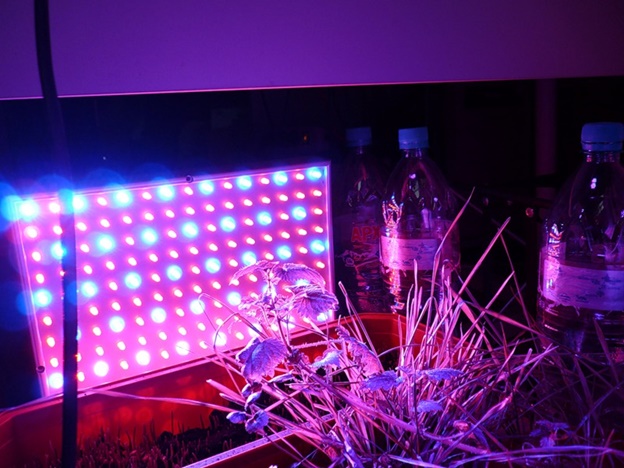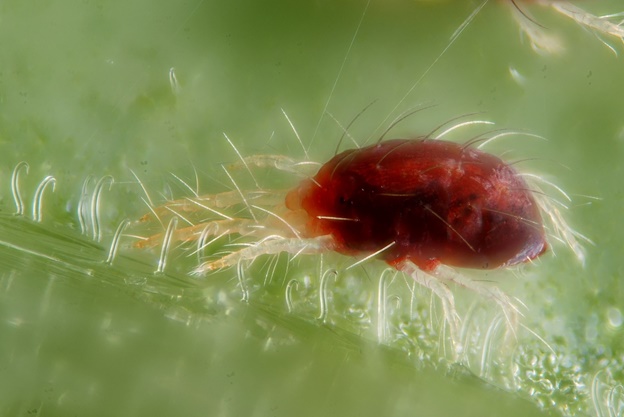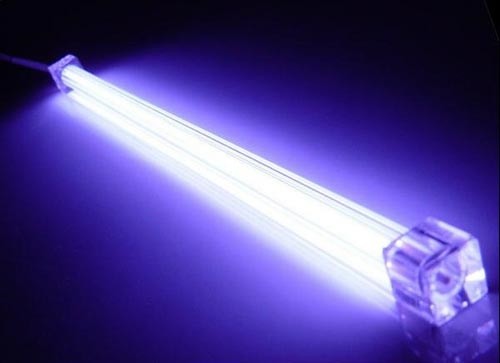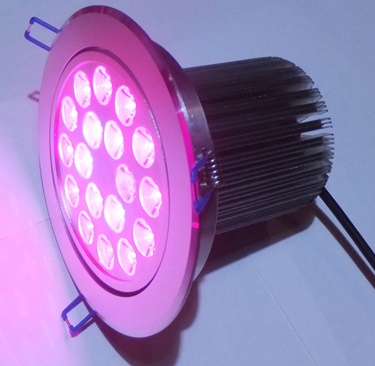Types of ultraviolet radiation. How to make an ultraviolet lamp for flowers
In practice, three types of artificial sources of ultraviolet radiation are used.
1. Erythemal fluorescent lamps (LE, EUL) are sources of ultraviolet radiation in regions A and B. The maximum emission of the lamp is region B (313 nm). The lamp is used for preventive and therapeutic irradiation of children. The EUV lamp is made from a special type of glass (uviolic), which transmits UV radiation well. The inside of the lamp tube is coated with phosphor (calcium phosphate activated by thallium) and filled with a dosed amount of mercury with an inert gas at a pressure of several millimeters of mercury.
EUV lamps are produced with a power of 15 W (EUV-15) and 30 W (EUV-30).
2. Direct mercury-quartz lamps (PRK) or arc mercury-quartz lamps (MAQ) are powerful sources radiation in the ultraviolet regions A, B, C and the visible part of the spectrum.
The maximum radiation of the PRK lamp is in regions B (25% of the total radiation) and C (15% of the total radiation). In this regard, PRK lamps are used both for irradiating people with preventive and therapeutic doses, and for disinfecting objects external environment(air, water, etc.).
PRK lamps for irradiating people are used with extreme caution, since significant amounts of UV radiation in area C can lead to damage to the mucous membrane of the eyes (photoophthalmia), changes in blood composition, etc. The irradiation time and distance to the lamp are strictly dosed, the eyes of irradiated persons and personnel are protected with dark glass glasses. The PRK lamp is made of quartz glass and filled with a dosed amount of mercury and argon. Currently, three types of PRK lamps are used: PRK-2 (375 W), PRK-4 (220 W), PRK-7 (1000 W).
Two types of beacon-type irradiators have been developed for PRK lamps:
a) large mercury-quartz irradiator (for PRK-7 lamps). Its stand has a constant height.
b) small mercury-quartz irradiator (for PRK-2 and PRK-4 lamps). Its stand can be of different heights.
3. Germicidal lamps made of uviol glass (BUV) are sources of UV radiation in region C. The maximum radiation of BUV lamps is 254 nm. They are used only for disinfecting environmental objects: air, water, objects (dishes, toys).
The radiation from UV lamps is dosed carefully, since short-wave UV radiation has a significant abiotic effect. The eyes are protected with glass glasses to prevent photoophthalmia. BUV lamps are filled with argon with a dosed amount of mercury at a pressure of 10 mmHg. Art.
They produce lamps with a power of 15 W (BUV-15), 30 W (BUV-30), 60 W (BUV-60) and 30 W with increased current density (BUV-30P). For BUV lamps, special shielding equipment has been developed that directs the rays so that the switched on lamp is not visible standing man. The fittings reduce bactericidal exposure in the area where people are indoors and protect the eyes from direct exposure.
Currently, there are two types of shielding fittings: NBO or PBO irradiators and combined irradiators designed for lighting fluorescent lamps and BUV lamps.
Use of artificial long-wave UV radiation to irradiate people.
Light irradiation installations. There are two types of irradiation installations: long-term and short-term.
The first irradiation method involves irradiating conventional (or improved) artificial indoor lighting with ultraviolet rays using UV radiation sources. All people in the room are irradiated during the entire time they are in it with a low-intensity UV flux (light irradiation installations).
Erythemal light irradiation units are called lighting installations, in which, in addition to luminescent and ordinary lamps incandescent UV lamps are installed.
They are used: in children's institutions, medical institutions, residential buildings(dormitories) north of 60° N, gyms, industrial premises without natural light. The operating time of the installation depends on the light climate: for northern regions– from October 1 to April 1; for medium-sized ones – from December 1 to April 1. People are indoors in ordinary clothes; their face, neck and arms remain exposed. Irradiators are installed on the ceiling or wall, at a level of 2.5 m from the floor. The duration of irradiation depends on the time of use of this room (in school classrooms 4-6 hours, in kindergartens 6-8 hours, etc.) UV irradiation is done in biodoses.
Determination of biodose for an adult. The threshold erythema dose, or biodose, is the amount of erythema radiation that causes barely noticeable redness (erythema) on the skin of an untanned person 6-10 hours after irradiation. This dose is not constant: it depends on gender, age, health status and other individual characteristics person. The biodose is established experimentally for each individual or selectively for the most weakened individuals who will be exposed to irradiation. It is determined using a biodosimeter with the same source of artificial UV radiation that will be used for preventive irradiation (ECV or PRK lamps). To prevent ultraviolet deficiency healthy people it is necessary to receive 1/10 – ¼ biodose daily.
Calculation required quantity light irradiation installations with EUV lamps. Number of erythema fluorescent lamps determined according to the schedule, if the prophylactic dose is 1/10 of the biodose. In other cases, the required number of EUV lamps is determined by formulas.
F mouth = 5.4xSxH p /t,
where F mouth is the total erythemal flow of the entire installation, mayor;
5.4 – safety factor;
S – area of premises, m2;
H p – dose of preventive UV irradiation, min/m2;
t – installation operating time, min.
Because the biodose is equal to 5000 mayor min/m2, then ¼ of the biodose will be 1250 mayor min/m2, 1/10 – 500 mayor min/m2, etc. The irradiation time is prescribed by the doctor, taking into account the length of people’s stay in the room (at least 4 and no more than 8 hours).
The number of erythema lamps is calculated using the formula:
n = F mouth /F 1, where n is the number of lamps;
F 1 – erythemal flux of one EUV lamp, mayor.
The erythemal flux of the EUV-15 lamp is 340 mayor, the EUV-30 lamp is 530 mayor.
Many people keep indoor plants in their apartments. However, for some it is not only great way revive and decorate the interior of the house, but also an option for making good money. Today, many people grow indoor flowers for sale at home.
To get a beautiful and healthier indoor plant, which will not only please the eye, but will also serve as an excellent addition to the family budget, it is necessary to create favorable growing conditions for the plant. And what is most important for plants if not light. Flower growers often use ultraviolet lamps to grow indoor flowers.
This type of lighting device will provide any type of indoor plant with the light flux necessary for its life. Moreover, such a lamp can either be purchased in a store or made by hand. Our article today will tell you what you need to consider and know when making and using ultraviolet lamps for plants.
Phytolamp: what is it?
An ultraviolet lamp designed for additional illumination of indoor plants is also called a phytolamp. This one is unusual lighting fixture used to ensure light mode certain types of indoor flowers.
Pay attention! The greatest need for this type of lamp arises in the autumn-winter period.
Phytolamp option
If the optimal light regime is not created for the plant, it will soon wither and die. The use of ultraviolet lamps will prevent such a sad outcome, and your indoor flora will develop within the required framework. In this situation, such a lamp will be perceived by the flower as a kind of artificial sun. The light from the lamp will be used by the plant for photosynthesis in the same way as from the real sun. As a result of such illumination, the flower will release oxygen and energy, which will go towards the growth and development of the plant. This way your indoor flora will receive optimal conditions for growth and will delight you with health, excellent appearance and beautiful flowering.
Pay attention! It is advisable to use ultraviolet illumination only for those ornamental plants who need long daylight hours. Usually these are flowers whose homeland is tropical and well-lit areas.
But it is not always possible to create suitable conditions for a home “mini-garden” without costs in terms of power consumption. In order to minimize costs and increase the survival of plants at home, ultraviolet lamps were invented.
What kind of lighting is required to grow plants?
When creating artificial lighting indoor plants with your own hands, you need to know what kind of lighting the flowers actually require. Otherwise, you can create the wrong lighting, which will only accelerate the death of your home front garden.

Lighting indoor plants
The luminous flux created by the phytolamp must meet the following requirements:
- be as close as possible to the natural light that the sun provides throughout the day;
- the duration of lighting should coincide by hour with the requirements of a particular type of indoor flowers;
- the spectrum of electromagnetic healing that the lighting device creates should be similar to the natural lighting conditions of the plant in the wild;
- at least minimal satisfaction of the flower’s needs for light;
- the level of ultraviolet radiation must meet the standards and not exceed them.
Pay attention! Today, there are a wide variety of phytolamps that are capable of producing different luminous fluxes in terms of power and other characteristics. As a result, their impact will also be different. Such a lamp, purchased or made with your own hands, can stimulate the development of shoots and fruits, speed up or slow down flowering, etc.

Flower's reaction to light
If the type of phytolamp was chosen incorrectly, then the plant itself will signal you about this with an uncharacteristic appearance:
- withered or drooping leaves;
- the appearance of sunburn on the leaves;
- fading of the leaf blade;
- lack of flowering period or fruit formation;
- the appearance of pests. Most often you can find a brood in a pot spider mite;
- the appearance of a disease on the plant, etc.
Today, artificial lighting, which is implemented by such a lamp, has several usage patterns:
- stimulation of photosynthesis intensity. In this case, the lamp is used as an additional light source;
- periodic use case. It involves turning on additional lighting if it is necessary to artificially increase the duration of daylight hours. This scheme relevant for the autumn-winter period;
- scheme for complete replacement of natural light. Makes it possible to fully regulate the process of development and growth of the entire home front garden.
Pay attention! The scheme for completely switching plants to artificial lighting can only be used in those rooms where it is possible to control the climate. In this case, maintaining a balance of growing conditions will allow you to get strong and healthy plants.
What you need to know when using phytolamps
To use artificial ultraviolet or any other type of DIY lighting, you must adhere to the following recommendations:
- The closer the lamp is located to the plant object, the more pronounced its effect will become. But here you should be very careful not to create a situation where the lamp emits excessive heat. This can lead to negative phenomena;
Pay attention! When the light source is 20 cm away from the plants, the effectiveness of such illumination will be achieved using 70-watt lamps on each square meter land.

Ultraviolet lamp placement
- when daylight hours are shortened in the cold season, the time of illumination of flowers should be increased by four hours;
- the light flux emitted by the lamp must be directed directly at the plant.
Using additional artificial lighting carries the following advantages:
- makes it possible to grow any flowers at home, even from tropical countries;
- allows you to create a small garden at home and grow plants even in winter;
- as an option for eliminating spider mites.
The last option should be discussed in more detail. Under the best growing conditions in pots, signs of spider mites can be detected. Spider mites are characterized by the appearance of cobwebs on the plant.

Spider mite
The presence of spider mites in the pot indicates that the plant is sick. The reasons for the appearance of spider mites can be either improper care or infection of healthy indoor flora from an overgrown flower brought into the house. Due to the presence of spider mites, plants cannot develop normally and soon die. Therefore, if this tick is found on decorative flowers, you need to immediately start fighting it. Most often, an ultraviolet lamp, which is either made by hand or simply purchased, has proven itself in eliminating spider mites.
UV influence of the lamp on living objects
It is known that there must be compelling reasons for using ultraviolet radiation. This is due to the fact that, for the most part, such radiation has negative impact on the growth and development of plants, as well as other living objects (for example, spider mites).

Ultraviolet radiation
Only the following radiation colors are useful for plants:
- red – promotes seed germination;
- blue – provokes cell division;
- purple – allowed in small quantities. Has a stimulating effect.
To illuminate plants, an ultraviolet lamp, purchased or made by yourself, should not emit far ultraviolet radiation. Therefore, tanning lamps and bactericidal lamps are not suitable for these purposes. Because of this, it is very important to choose the right lamp or make your own lamp for lighting indoor plants.
How to choose the right phytolamp

UV lamp option
When intending to use an ultraviolet phytolamp, it is important to choose the right device so that its negative effect on living objects is minimized. Here you need to be guided by the following selection parameters:
- minor ultraviolet radiation;
- refusal of lamps that produce far ultraviolet radiation;
- purpose of the product. For what purposes is the lamp supposed to be used: accelerating the development of a plant or seeds or simply maintaining daylight hours;
- at what distance should the device be placed from plantings or flower pots;
- the angle of radiation produced by a particular ultraviolet lamp;
- the desired radiation spectrum. It is determined by the purpose of the product;
- dimensions of the lighting device. The size of the lamp should cover the area to be illuminated. If necessary, you can use several lighting fixtures.
In addition, phytolamps with ultraviolet radiation should consume a minimum of electricity so as not to scare you with utility bills.
Also, when choosing a lighting device, you need to take into account the variety of plants for which they are intended to illuminate.
Making your own phytolamp
Today, almost any lighting fixture can be made with your own hands and without spending money on buying a device in a store.
You can make your own lamp with ultraviolet radiation for illuminating plants with virtually no problems. In order to make such a phytolamp with your own hands, you will need basic knowledge in electrical engineering, some materials and the desire to make something on my own.
Pay attention! A kit for self-assembly of an ultraviolet lamp can be purchased at the store.
To assemble such a lamp you will need:
- metal or wooden base;
- power unit;
- ultraviolet light source with the necessary characteristics;
- wires;
- drivers;
- connector;
- fastener or solder.
Some of the above parts can be taken from old lamps.
The manufacture of the device occurs as follows:
- an ultraviolet source must be placed on the selected base;
- then wires are connected to it;
Pay attention! When connecting wires, polarity must be observed.
- you also need to connect the connector, driver and power supply to the circuit. For assembly you can use the following diagram;

Assembly diagram of an ultraviolet lamp for flowers
- When all the elements of the lamp are connected, it is necessary to secure them to the base. Such products can be covered with a glass case or without it at all;
- After this, you need to check that all elements are connected correctly by connecting the lamp to the power supply.
After this, all you have to do is correctly position the ultraviolet lamp, made by yourself, near the plants.
Conclusion
To make an ultraviolet phytolamp with your own hands, you need to take into account many nuances and recommendations. Otherwise, such a lamp can lead to the death of the illuminated plants. At the same time, it is not enough to make such a lighting device; it also needs to be placed correctly so that all the efforts expended are not in vain.
For more than a century, ultraviolet radiation has been successfully used, which has a positive effect on human immunity. This light compensates for ultraviolet deficiency and increases the body’s ability to resist viruses. Moreover, the ultraviolet irradiator helps normalize the biochemical composition of the blood, is used to treat many inflammations, and has a beneficial effect on the heart, blood vessels, and lungs. Ultraviolet lamps are recommended for use in medical and educational institutions, sanatoriums, for prevention purposes at home, etc.
The UV lamp also has such names as mercury-quartz, bactericidal, quartz lamp, sterilizer, irradiator. The effect of a quartz lamp in its healing characteristics is similar to the effect of antibiotic drugs, however, without harm to health.
An ultraviolet irradiator disinfects the air, preventing the spread of airborne infections and viruses. Maintains the condition of the premises as close as possible to accepted sanitary standards. In rooms where there is a possible risk of spreading viral pathogens, a bactericidal irradiator works especially effectively.
The UV irradiator has wide range uses:
- Apartments, houses;
- Educational institutions(school, kindergarten);
- Public catering;
- Beauty salons;
- Enterprises;
- Retail outlets;
- In production, in the office.
Ultraviolet lamp for the home - an effective and simple method to avoid colds in winter. The ultraviolet irradiator is relevant at any time of the year and will effectively disinfect the room, preventing the spread of infections, and will also be a good additional tool for:
- With a lack of vitamin D in the body;
- Allergies and bronchial asthma;
- Various skin ailments;
- Bronchitis;
- Allergic rhinitis;
- Joint diseases;
- Trophic ulcers, bedsores;
- ENT diseases;
- Myositis;
- Compensation for UV deficiency.
The ultraviolet lamp, the price of which in our company is very affordable, is distinguished by high quality, ease of operation, versatility, stylish design and excellent ergonomics, and the production process uses the most modern technologies. All models of UV lamps presented on the site are assembled using high-quality components, which guarantees a long service life of the products.
